The Lucid Air Is So Good It Should Make Tesla Sweat

For Peter Rawlinson, the guitar-playing founder and chief executive of Lucid Motors, it’s been a long, strange trip bringing the Lucid Air to fruition. The longest-lasting, most power-dense production EV to date offers up to 520 miles of EPA-certified battery range, plus a 9.9-second, 144-mph rip through the quarter-mile. Even by jaded automotive journalist standards, the Air is a stunning engineering achievement, the new benchmark for the world’s electric sedans—a title that’s partly incumbent on how many Lucid can sell.
We’re taking a breather in a pair of Lucid Air Dream Edition sedans in Tortilla Flat, Arizona, population 6, a former stagecoach stop in the spectacular Superstition Mountains, just a few hours from Lucid’s rapidly expanding greenfield factory in Casa Grande. Where other publications here are limited to brief teaser drives as part of a factory visit, we’ve finagled a 1111-hp Air Dream Edition Performance for a full dawn-to-dusk. Perhaps Rawlinson is feeling nostalgic: He recalls a 1994 Road & Track story on his CAD-designed Imola, a Chapman-esque British kit car with a stainless steel monocoque. The article helped him land a job at Lotus in 1995, where he rose to chief engineer; his Imola influenced the second-gen Elise. Next stop, Norway, where he developed the Think electric car. Elon Musk, in the weeds on his first electric sedan and firing everyone in sight, plucked Rawlinson to lead engineering on what would become the world-changing Model S. You know the rest.
“This is kind of full circle for me,” the puckish Welshman says.
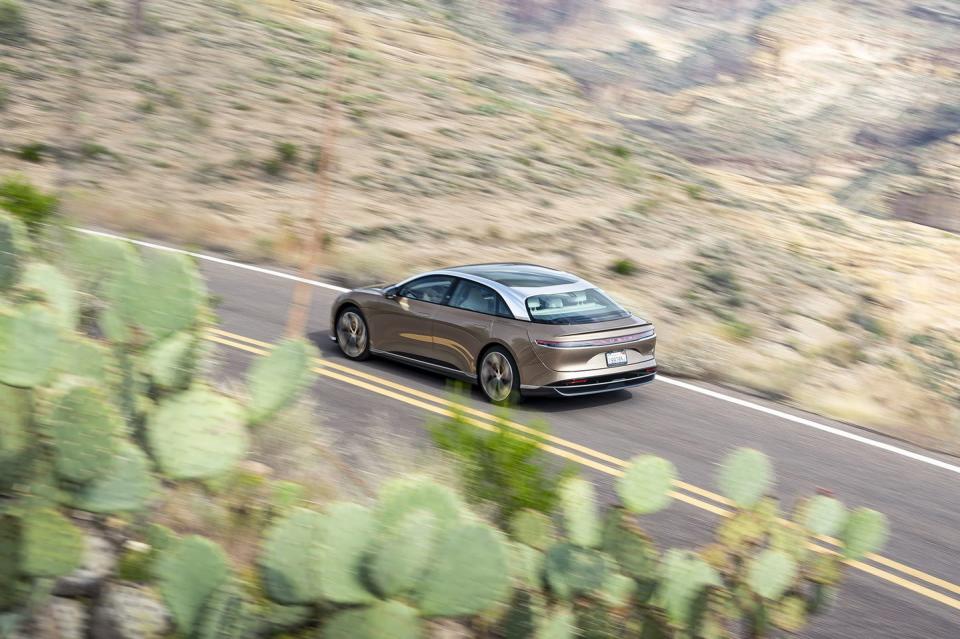
Nearly 30 years later, those circles are running faster thanks to the disruptive force of electricity—in every sense. I’ve spent the past few hours whomping the Air to 120 or 130 mph in the time it takes most cars to hit 60. With the Lucid dialed to Sprint mode, I struggle to put the spatial dislocation into words. You know how you flick a stray ant off a picnic table? In the Lucid Air, you are the ant.
Meanwhile, legacy automakers are choking on Tesla’s dust. Defying all odds for start-up car companies—and a cottage industry of naysayers—Tesla is on track to sell nearly 1 million electric cars worldwide this year, and its $888 billion valuation is nearly 10 times than of General Motors. Say what you will about Musk and his (lack of) charms; a million cars a year, and new factories coming online in China, Berlin and Austin, certainly ain’t smoke and mirrors, though the stock valuation might be.
Lucid wants to be where Tesla is: A recognizable car brand with an expanding portfolio and customers lining up for more. For now, Lucid execs insist the Air’s true targets are the Mercedes S-Class and other flagship internal-combustion cars, not the far-less-luxurious Model S. The 933-hp, 520-mile Lucid Dream Edition Range (yes, all of the model names are this unwieldy) beats Tesla’s best range by an eye-opening 115 miles, enough for nearly two bonus hours of highway cruising. An Air Grand Touring (for $140,400) earns a 131-MPGe rating, besting the 120 MPGe of the Model S Long Range, with 800 horses versus 670 for the Tesla.
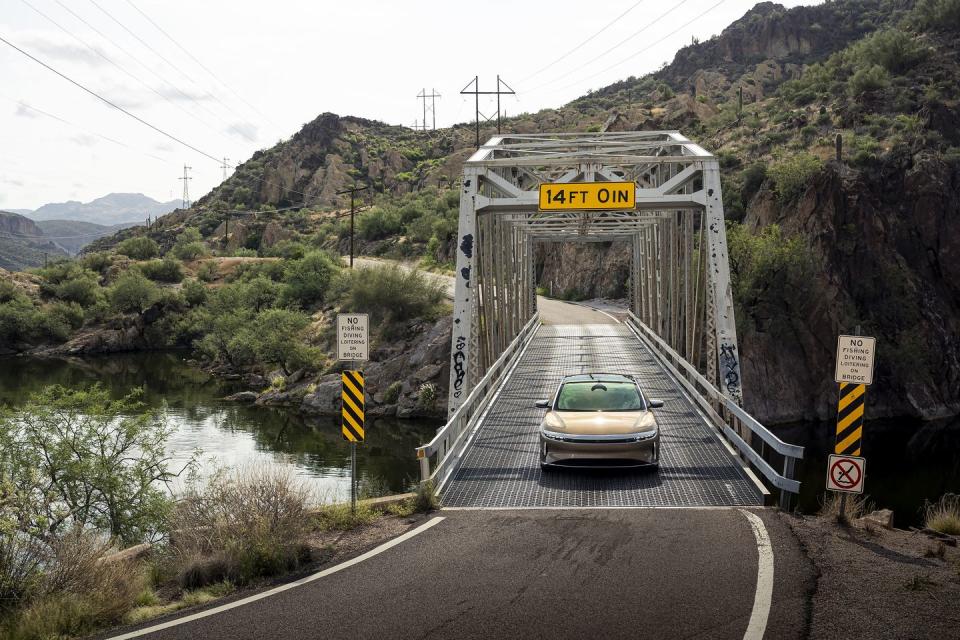
We watch some of the first, dual-motor Dream Editions (at $170,500, limited to 520 sold-out copies) roll off the assembly line, bound for early adopters beginning in late October. The company’s goals call for production of 20,000 Air sedans in 2022. That number would include a 650-hp, dual-motor Air Touring for $96,500. Late 2022 brings the affordable models that should help clarify Lucid’s prospects: A single-motor Air Pure with 480 horses and 408 miles of estimated range for $78,900. That’s about $12,000 less than a Model S Long Range, or $31,000 less than a 2022 Mercedes-Benz S500 with 51 fewer horses. (For any Air, a $7500 federal EV tax credit will help soften the blow). Another critical model, the Gravity SUV, is slated for 2023, followed by planned factory expansion into Europe and the Middle East.
Here in the Sonoran Desert, near the abandoned Lost Dutchman gold mine, the Lucid makes fast friends as it breaks cover in public. They include a posse of young outlaws in a high-horsepower convoy—Corvette Z06, Mustang Shelby GT500 and Dodge Hellcat, all painted black. Go hang, fellas: Lucid’s sprawling five-passenger sedan will beat them all in a drag race. And it won’t be particularly close; Lucid figures 0-60 takes just 2.5 seconds.
If Lucid does strike it rich, the Air’s curb- and cabin appeal will deserve due credit. This sweet lozenge of a sedan recalls a Citroen DS for the electric age, with deep-set LED headlamps, a clamshell hood, corseted waist and full-width animated lighting front and rear. An aluminum monocoque and body (with a composite decklid) is capped with an atrium-like glass canopy and brushed-aluminum roof pillars. Even the Lucid’s one visual scar, an awkward shut-line that borders its hatch-like trunk, marks a pragmatic benefit: an uncommonly low lift-over and a conveniently wide opening. Another deep storage space rests below the cargo floor. The industry’s largest frunk is more than double the size of a current Miata’s trunk, at 9.9 cubic feet. Lucid claims a best-in-class 26.1 cubic feet of total cargo space.
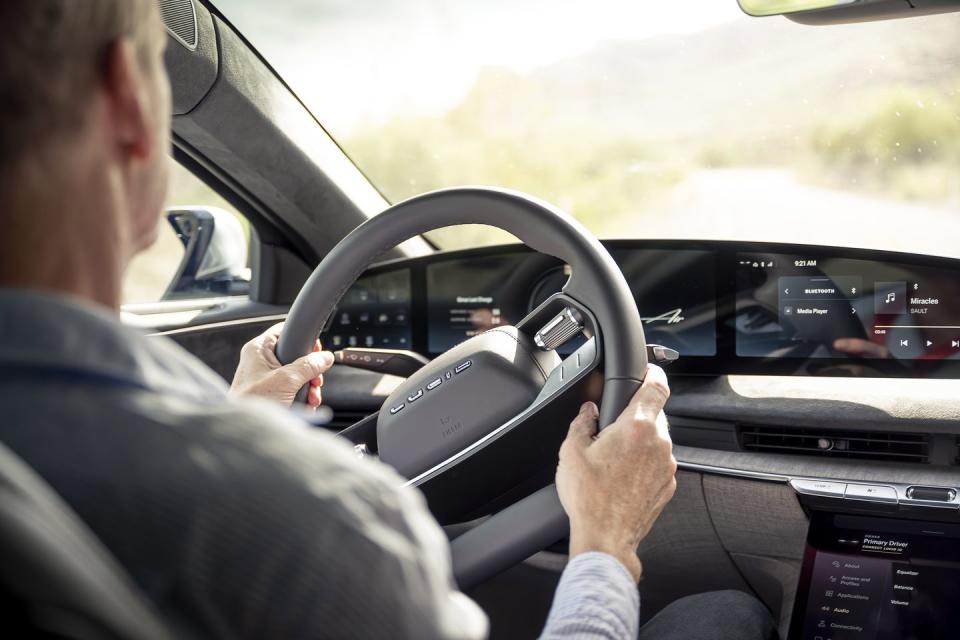
The Lucid, Model S and Porsche Taycan are closely matched in size, nearly identical in length. The Lucid is the narrowest of the bunch, but feels the roomiest, especially in its sprawling back seat. Compared with high-roofed sedans—including the S-Class, roughly a foot longer and 3.7inches taller—the Lucid’s rear seat cushions are positioned relatively low to carve out space. Rear passengers must duck below the curling roof for ingress and egress, but once aboard, even taller riders won’t complain.
Rawlinson says the Air’s drive unit brings nearly three times the power density of Tesla’s, at 3.98 hp per pound. That adds up to 650 horsepower from a motor, reduction gearbox, inverter and differential that weigh just 163 pounds and can fit inside a roller bag. That 20,000-rpm drive unit speaks to the company’s relentless focus on miniaturization. The Air’s 0.21 coefficient of drag, as tested by Lucid, would mark a slippery new record for any luxury vehicle. The motors are fed by 6600 cylindrical “2170” battery cells in 22 modules, the same basic cell format as Tesla’s newer cars. Rawlinson won’t reveal the Dream’s battery size, but insists it’s not decisively larger than the 112-kWh pack in the Air Grand Touring.
The Air and its battery pack also set another industry high for fast charging. Its 900-plus-volt architecture can add up to 300 miles of battery range in 20 minutes, or a quick 20-mile splash-and-dash in just 60 seconds. These charging feats revolve around the Wunderbox, an in-house designed piece of circuitry that can max out charging speeds on stations of widely varying voltages. It's also ready for a coming world of vehicle-to-vehicle (V2V) or vehicle-to-grid (V2G) applications, meaning your Lucid could keep your Netflix running and margaritas frosty during a power outage.
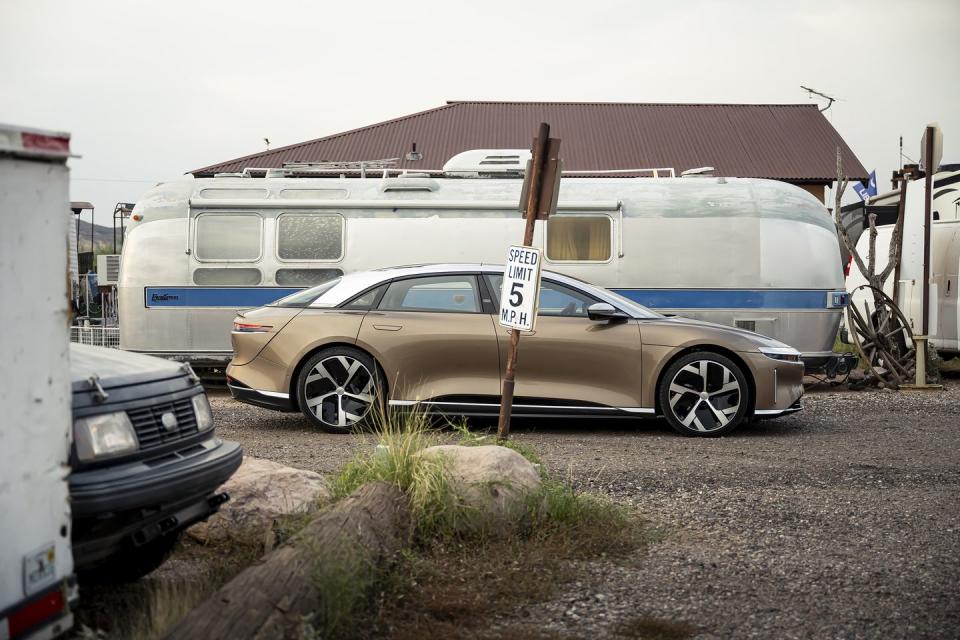
So much for range anxiety and thumb-twiddling charging stops—at least when the 350-kW DC chargers required for such speedy refills become more common. We’re unable to test the claim, despite a 350-kW Electrify America charging oasis in Tempe, because our pre-production model’s quick-charge software isn’t fully operational. But buyers will enjoy three years of free charging at EA stations.
That atrium-like roof, with sun visors affixed to the windshield, heightens the Air’s airy effect. And the Lucid manages to out-Volvo the Swedes with its tasteful, architecture magazine vibe. Is it really S-Class rich? Not entirely. Some accoutrements, such as the in-house audio system, can’t match M-B’s dazzling standards. But the massaging seats are excellent, and the Lucid’s posh quarters make a Tesla’s interior look like the mismatched Tupperware in the back of your cupboard. (Plus, no idiotic yoke steering wheel.) In Dream Editions, an exclusive “Santa Monica” cabin—one of several treatments inspired by California landscapes, minus the End Times wildfires—is decked out with open-pore silver eucalyptus wood, perforated Nappa leather, Alcantara suede, burnished metal and a tweedy blend of alpaca wool and yarn sourced from recycled plastic bottles.
A dramatic 34-inch, 5K display (actually three screens conjoined) curves before the driver like a set of wraparound shades. A smaller “Pilot Panel” screen motors down from the dash center to hover above the console, laden with cupholders and cubbies like some luxury minivan. The Lucid’s screen-centric effect, seemingly de rigueur in luxury EVs, makes its digital point without being overbearing or an ergonomic minefield. Derek Jenkins, Lucid’s senior VP of design, insisted on keeping some analog switches, bless him, including those for temperature, fan speed and audio volume. A suite of 32 sensors brings a sophisticated 120-degree Lidar unit and 14 cameras. One is a driver-monitor camera (which can be shut off) to help keep eyes on the road. The driver cam and Lidar are two technologies that a near-consensus of experts consider critical to eventual autonomous driving; a lone dissenter, Elon Musk, insists they’re superfluous.
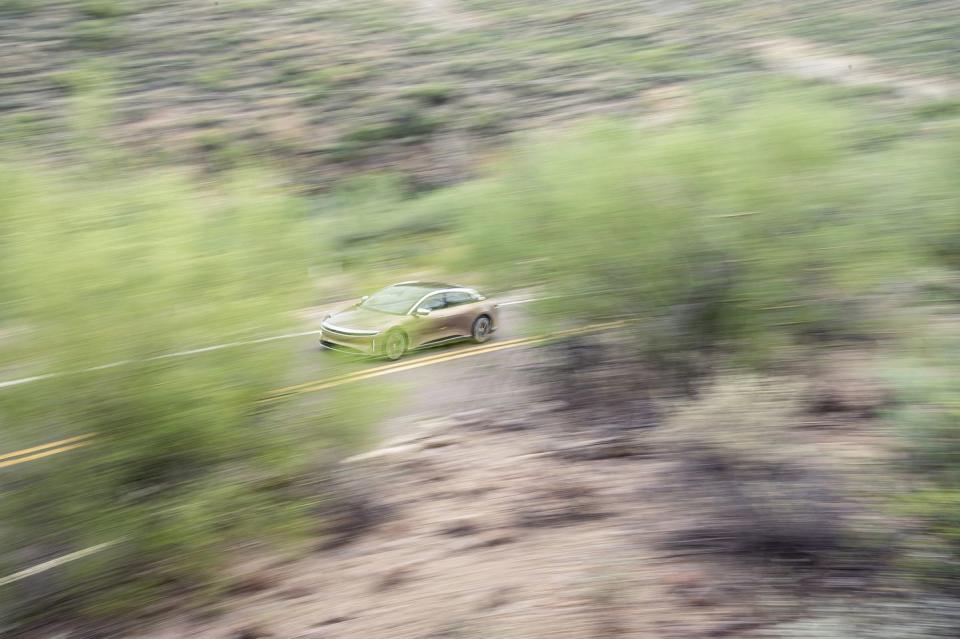
I originally envisioned driving the Lucid for a range test. The car had other, faster plans. The Air is a born autobahn rocket, one that Germany’s green party could get behind. A double-wishbone front suspension and multi-link rear pair with adaptive dampers. The suspension, steering and powertrain muscle up via Smooth, Swift and Sprint drive modes. The latter unleashes the Dream Performace’s full 1111 horsepower, up from 789 in mellower modes. Grip feels nearly unbreakable on optional 21-inch wheels that shave off 20 miles of driving range compared to the 471 miles you’d get on 19’s. Lateral traction is more impressive considering the car’s efficiency compromises. Pirelli developed the first “HL” rated tire for Lucid, allowing the Air’s 168-mph top speed but with low rolling resistance for efficiency. Even on the largest wheels, with their fan-like aero blades, the ride remains livable.
Hydraulic-only brakes could use more initial bite, but I say that about most super-powered luxury models. All regenerative braking is accessed by lifting off the throttle, and the programming is dead-on perfect, including a stronger setting for one-pedal driving that also works beautifully in corner-to-corner action. That setting let me use my right foot like a rheostat and barely fuss with the brake pedal. Balancing the car becomes a breeze, with a bonus of reduced brake wear. It also underlines the Taycan’s biggest oversight: Porsche neglected to offer a one-pedal driving mode, leaving critical regen mileage and driver personalization on the table.
In an era of Taycans and Uruses, the idea that a roughly 5050-pound (or more) vehicle can actually handle should no longer surprise. Still, the Lucid hustled like a thicker, late-period John Travolta. Or, to hone in on Lucid’s targets, like a big-ass AMG Benz, only much faster. A shapely steering wheel supplies pleasing heft and accuracy but not much road feel, also unsurprising in an electric car. The Taycan feels smaller from behind the wheel, and remains the king of sporty sensation in EVs. But with so much AWD thrust and grip, the flat-handling Lucid will melt almost any ICE car it encounters in public: Squeeze the throttle, and the next corner arrives faster than a high-speed download. Other cars are strictly snail mail.

Following my own enlightening workouts, Rawlinson takes his own rocketing pass through these forbidding volcanic mountains, with me riding shotgun. The founder frets over a trace of front-end pitch, and assures me it’s being addressed with a rolling change: 10-percent softer front springs and a 10-percent stiffer stabilizer bar. The company plans to address the Tesla Model S Plaid and its accelerative edge via its own tri-motor version of the Air. I toss out a rough guess of 1400 horsepower. Rawlinson smiles and doesn’t deny it.
Even our Lucid’s 1111 horses is ridiculous, prodigal power, but it’s only fair: ICE automakers have shamelessly marketed horsepower and speed for more than a century. Now, their time is running out. Too dramatic? Well, when Lucid went public via a blank-check merger, the Kingdom of Saud—ruled by one Mohammed bin Salman—ended up owning about 65 percent of the upstart automaker. The Saudis already stand to earn $20 billion profit on an original $2.9 billion investment. Rawlinson acknowledges that the arrangement strikes some observers as odd, but argues it’s actually not: The Middle East knows full well that its oil will either run out or be regulated out of use. But their blazing sun might power the earth’s electrified transportation for 10 billion years. Which gives us plenty of time to screw things up again, or come up with better ideas.
You Might Also Like

